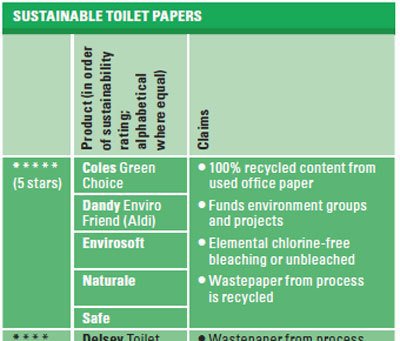Can you cut 1 Tonne of carbon pollution out of your life?
Take the challengeWe all need it, we all use it. It may say 'green' or 'recycled', but have you ever wondered just how sustainable your toilet paper really is?
Today has previously reported, "According to the Australian Conservation Foundation (ACF) every tonne of paper recycled saves 13 trees, 2.5 barrels of oil, 4100 kilowatts of electricity, four cubic metres of landfill and 31,380 litres of water. 'Only five percent of the toilet paper we flush away in Australia is made from recycled paper,' Jon Dee (environmentalist) says. 'The rest is virgin fibre from plantation or native-forest trees.'"
Worldwide, the equivalent of almost 270,000 trees is either flushed or dumped in landfills every day and roughly 10 percent of that total is attributable to toilet paper.
A study by CHOICE shows toilet paper packaging often sports vast amounts of green claims - but as usual, many of the brands assertions don't stack up when you dig a little deeper. Today we want to share the buzzwords that cover your TP packets and what they really mean.
BIODEGRADABILITY:
Not an environmental claim as such, more of a benefit to the sewer systems. CHOICE also explains that, "not a good differentiator, since any toilet paper made from a plant fibre biodegrades."
BLEACHING:
Bleaching refers to the process used to whiten the toilet paper (duh). Many packets claim “elemental chlorine-free bleaching"- but don't be fooled, this process still involves chlorine. The most sustainable choice is a toilet paper which is unbleached.
PACKAGING:
You'd be hard pressed to find a TP packet that's not sporting a recycling symbol - normally with the number four and sometimes 'LDPE' (low-density polyethylene) written underneath. Don't be fooled and assume this mean the packet is recyclable.
CHOICE explains that most councils prohibit LDPE from their curb-side recycling bins.
They do take:
- PET (Polyethylene terephthalate) - soft drink and fruit juice bottles - HDPE (High-density polyethylene) - milk bottles or shampoo containers - PVC (Polyvinyl chloride or plasticised polyvinyl chloride) - cordial, juice or squeeze bottles Check your with your local council and see if LDPE is accepted in your area. The CHOICE study found the only toilet paper packaging that could practicably recycled was the paper-wrapped kind.
ENVIRONMENTAL SUPPORT:
A very common form of greenwashing is logos from environmental organisations emblazoned on the packet. Yes, this means that some of the profits will go to these organisations- but it doesn't mean the toilet paper is made sustainably.
So which toilet paper can you trust? This infographic from CHOICE rates the toilet paper available at supermarkets on their sustainability claims.

Here are some other great toilet paper brands/ideas to look into:
Other sustainable brands available
- Shop Ethical guide to toilet paper.
(toilet paper that builds toilets) - Toilet paper made from 100% recycled fibres. 50% of their profits go to WaterAid to build toilets and improve sanitation in the developing world.
- This blog explains why cloth toilet paper is a viable alternative.
Header Image: Earth Rangers Centre
What you can do
Do shopper research on carbon footprint before you buy
CO2 pollution is embedded in everything we buy. By looking for Australian-made products, credible environmental claims, and minimal and recyclable packaging, we can minimise pollution.
savings pledged

